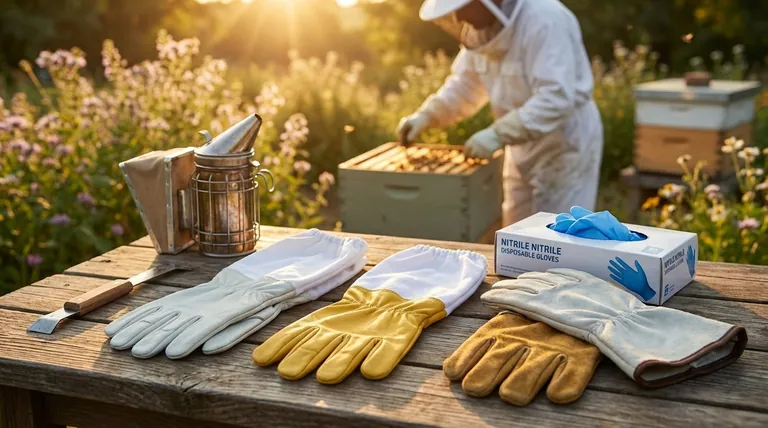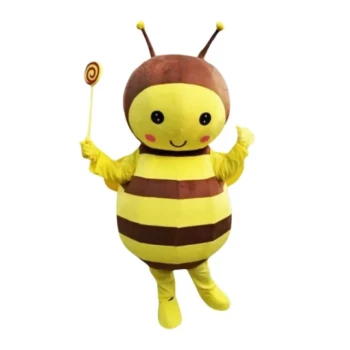The most common beekeeping gloves are made from leather, goatskin, or nitrile. Each material offers a distinct balance between protection from stings and the dexterity needed to handle bees and equipment gently. Leather provides the highest protection but is cumbersome, while nitrile offers the best dexterity with surprisingly good sting resistance.
The core decision in choosing beekeeping gloves is navigating the fundamental trade-off between maximum physical protection and the tactile sensitivity required to work with your bees safely and effectively.

Why Gloves Are an Essential Tool
For beekeepers, especially those just starting, gloves are about more than just preventing stings; they are a critical piece of equipment for building confidence and good habits.
Protection from Stings
The most obvious function of beekeeping gloves is to shield the hands and forearms from stings. Most dedicated beekeeping gloves feature long sleeves, or gauntlets, with an elastic closure to ensure no bees can crawl inside.
Building Confidence
For a beginning beekeeper, the fear of being stung can cause nervousness and jerky movements. Wearing gloves provides a sense of security, allowing you to work calmly and deliberately, which is safer for both you and the bees.
The Primary Glove Materials Explained
The material of your glove directly impacts your experience. Understanding the characteristics of each type is key to making the right choice.
Cowhide Leather Gloves (Maximum Protection)
These are the traditional, heavy-duty option for beekeepers. They offer the highest level of physical protection against stings.
However, their thickness is also their biggest drawback. Leather gloves are often cumbersome, significantly reducing your dexterity and ability to feel what you are doing.
Goatskin Gloves (The Balanced Option)
Goatskin is a popular compromise, offering a middle ground between cowhide and nitrile. It is thinner and more flexible than cow leather.
This results in a noticeable improvement in dexterity while still providing a very good level of sting protection, making it a favorite for many beekeepers.
Nitrile Exam Gloves (Maximum Dexterity)
Though it may seem counterintuitive, disposable nitrile exam gloves are a highly effective option. They offer an excellent barrier against stings.
Their primary advantage is that they barely limit dexterity. This allows you to feel frames and equipment precisely, reducing the chance of accidentally crushing a bee, which can trigger a defensive response from the hive. They also keep your hands clean from honey and propolis.
Understanding the Trade-offs
Your choice of glove isn't just about the material; it's about your philosophy and comfort level as a beekeeper. There is no single "best" glove, only the best one for you and your current task.
The Impact of Dexterity
Reduced dexterity from thick gloves can lead to clumsy movements. You might drop a frame or crush bees, which agitates the colony and can lead to more stings, not fewer.
The Need for Tactile Feedback
Experienced beekeepers often prefer thinner gloves because feeling the hive is crucial. Tactile feedback helps you move gently and deliberately, respecting the bees' space and minimizing disruption.
Fit Is Non-Negotiable
Regardless of the material, your gloves must fit comfortably. A poorly fitting glove, whether too tight or too loose, will hinder your ability to perform essential tasks like lifting frames or inspecting the hive.
Selecting the Right Glove for Your Approach
Your experience level and personal comfort should guide your decision. Many beekeepers own multiple types of gloves for different situations.
- If your primary focus is building confidence as a new beekeeper: Start with goatskin or leather gloves to get comfortable handling bees with maximum peace of mind.
- If your primary focus is balancing protection and dexterity: Goatskin gloves are an excellent all-around choice for most day-to-day hive inspections.
- If your primary focus is precision and gentle handling: Use nitrile gloves for delicate tasks where tactile feel is more important than heavy-duty protection.
Ultimately, the right glove empowers you to be a calm, confident, and effective beekeeper.
Summary Table:
| Material | Key Characteristic | Best For |
|---|---|---|
| Cowhide Leather | Maximum sting protection | New beekeepers prioritizing safety |
| Goatskin | Balanced protection & dexterity | All-around daily hive inspections |
| Nitrile | Superior dexterity & tactile feel | Experienced beekeepers & precision work |
Equip your apiary with the right protection. HONESTBEE supplies high-quality beekeeping gloves and equipment to commercial apiaries and distributors through our wholesale operations. Ensure your team works confidently and efficiently with gear designed for the professional beekeeper.
Contact HONESTBEE today for wholesale pricing and to discuss your apiary's needs.
Visual Guide

Related Products
- Beekeeping Gloves Goatskin Leather with Long Cotton Sleeve for Beekeepers
- Goatskin Leather Beekeeper Gloves with Vent Long Sleeve for Beekeeping Honey Bee Sting Proof Protection
- Goat Skin Leather Bee Sting Proof Beekeeping Gloves with Canvas Sleeve
- Mesh Ventilated 3 Layer Goatskin Beekeepers Gloves for Beekeeping
- Professional Galvanized Hive Strap with Secure Locking Buckle for Beekeeping
People Also Ask
- What is the safest way to handle frames in beekeeping? Master Gentle Handling for a Calm Hive
- What are the arguments for and against using gloves in beekeeping? Balancing Protection and Dexterity
- What should beekeepers consider regarding the fit of beekeeping gloves? Achieve Safety and Dexterity
- Should beekeepers wear gloves, and why? Essential Protection for Beekeepers
- What are the advantages of goatskin leather gloves for beekeeping? Superior Sting Protection for Your Apiary



















